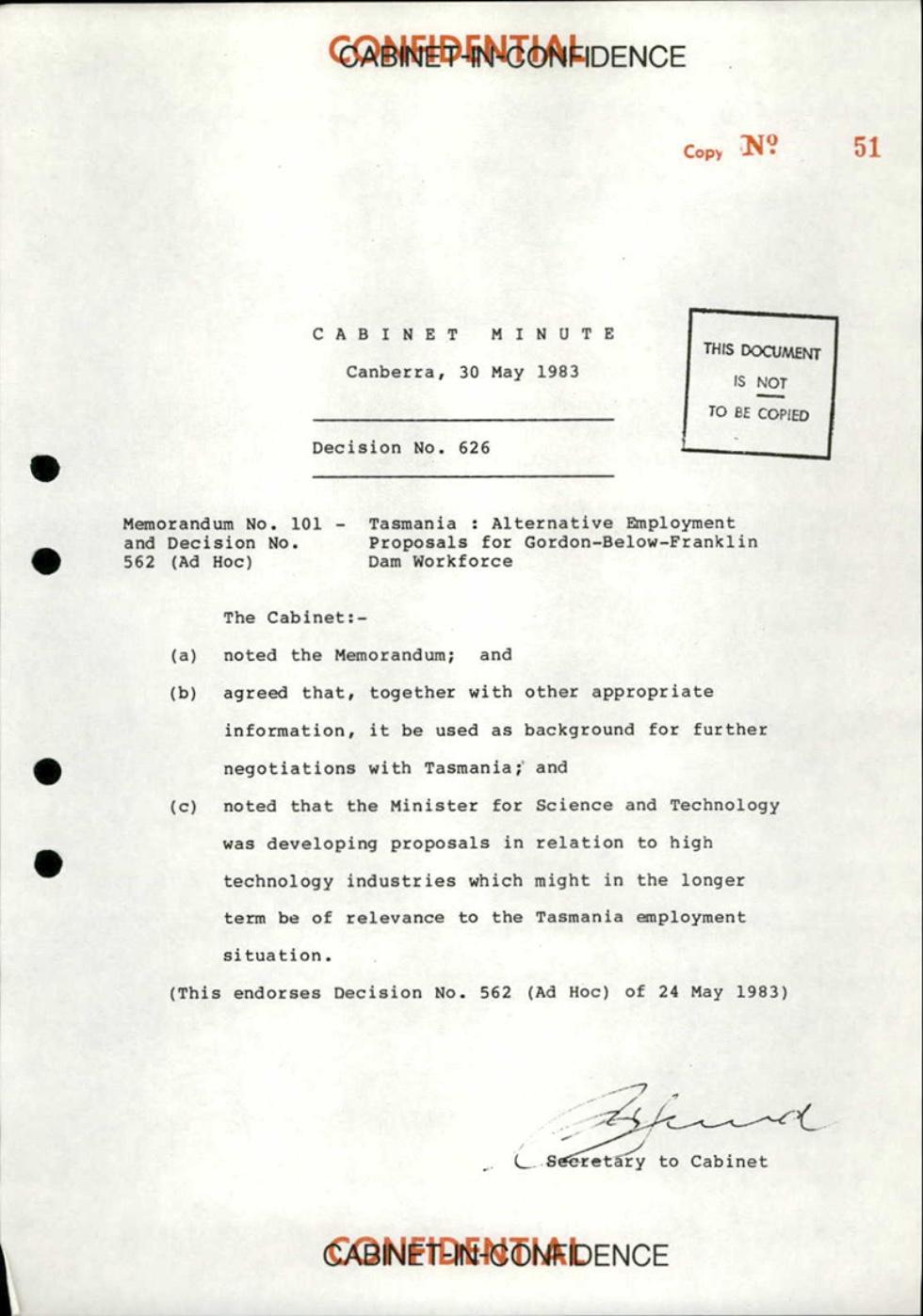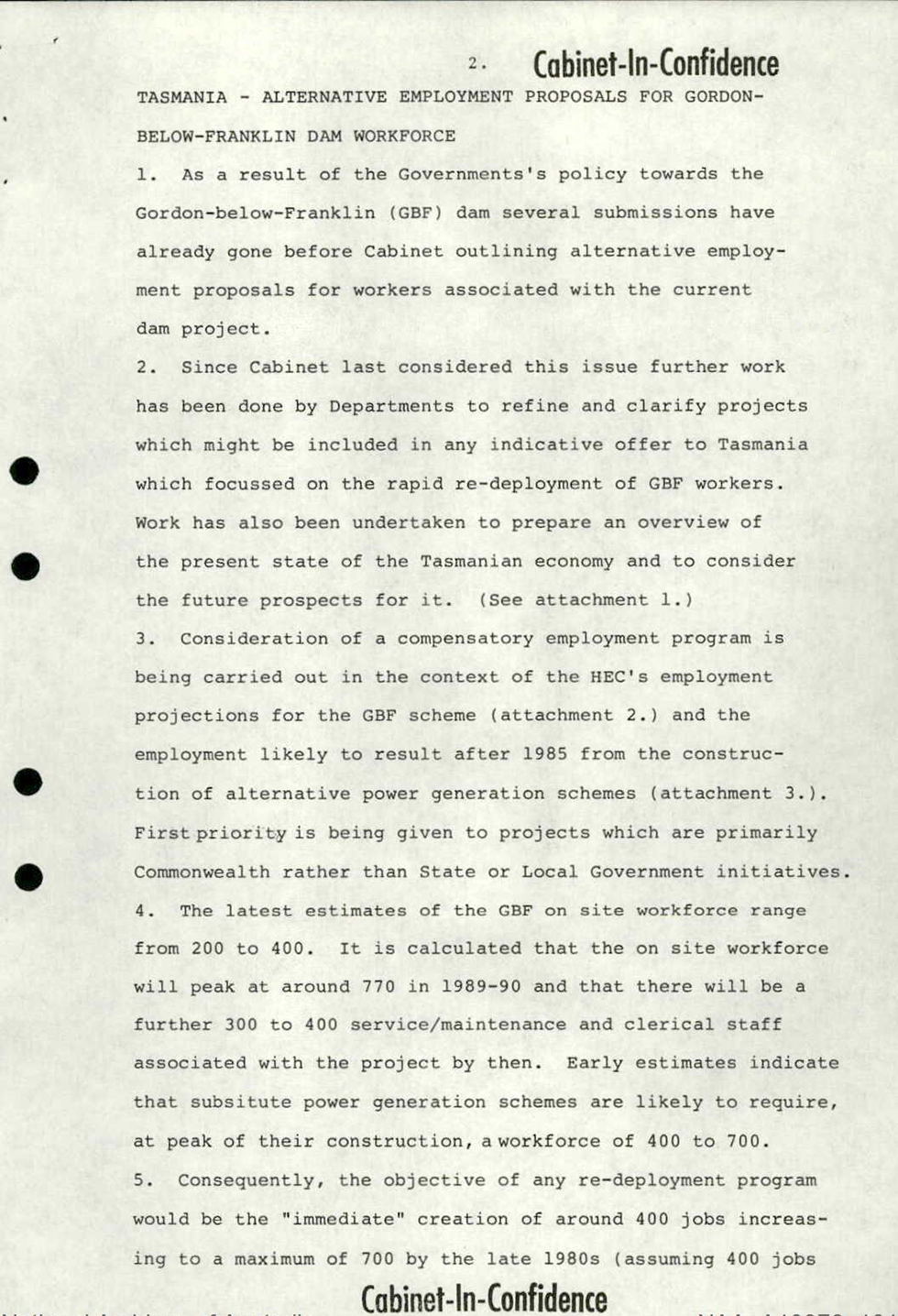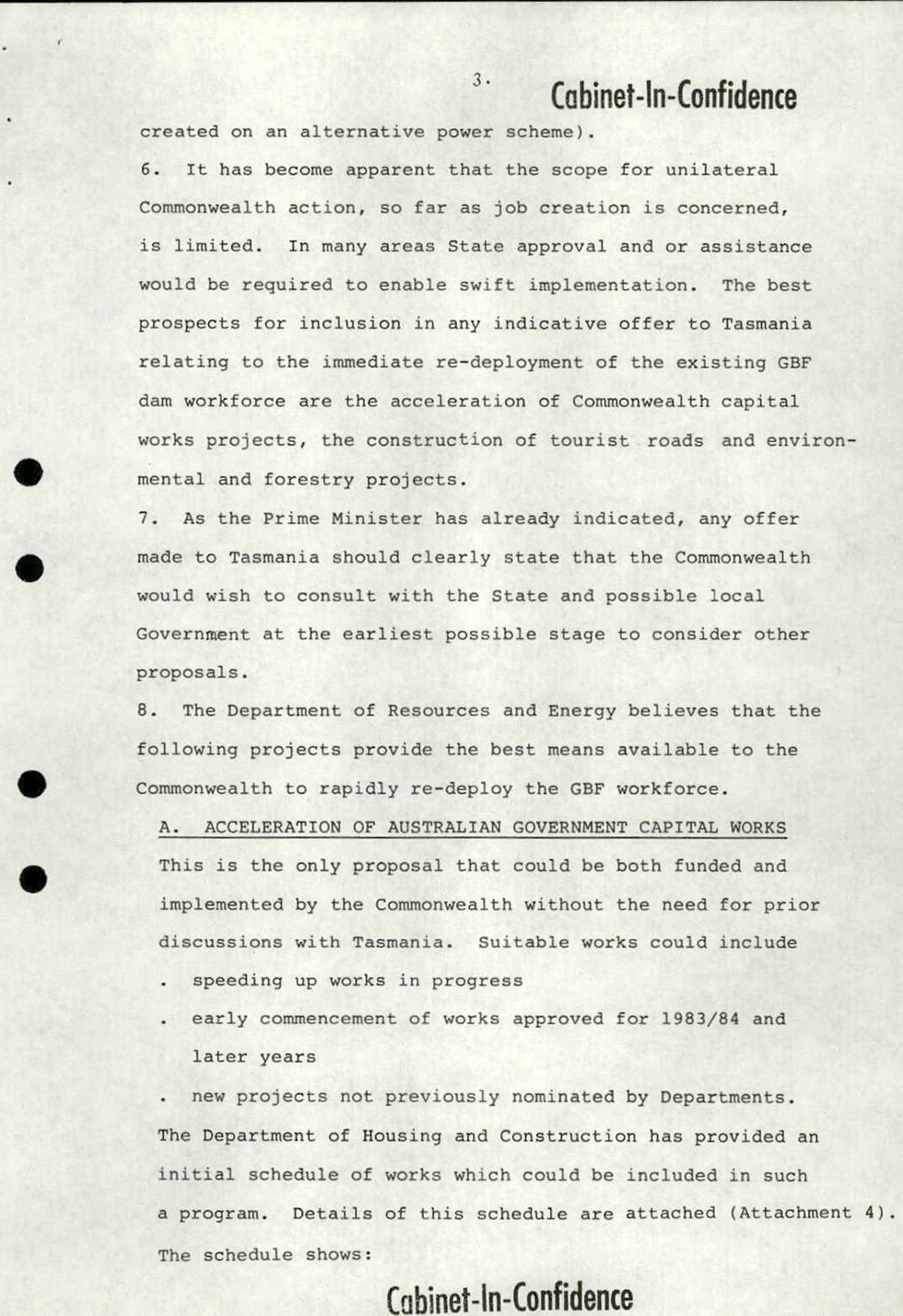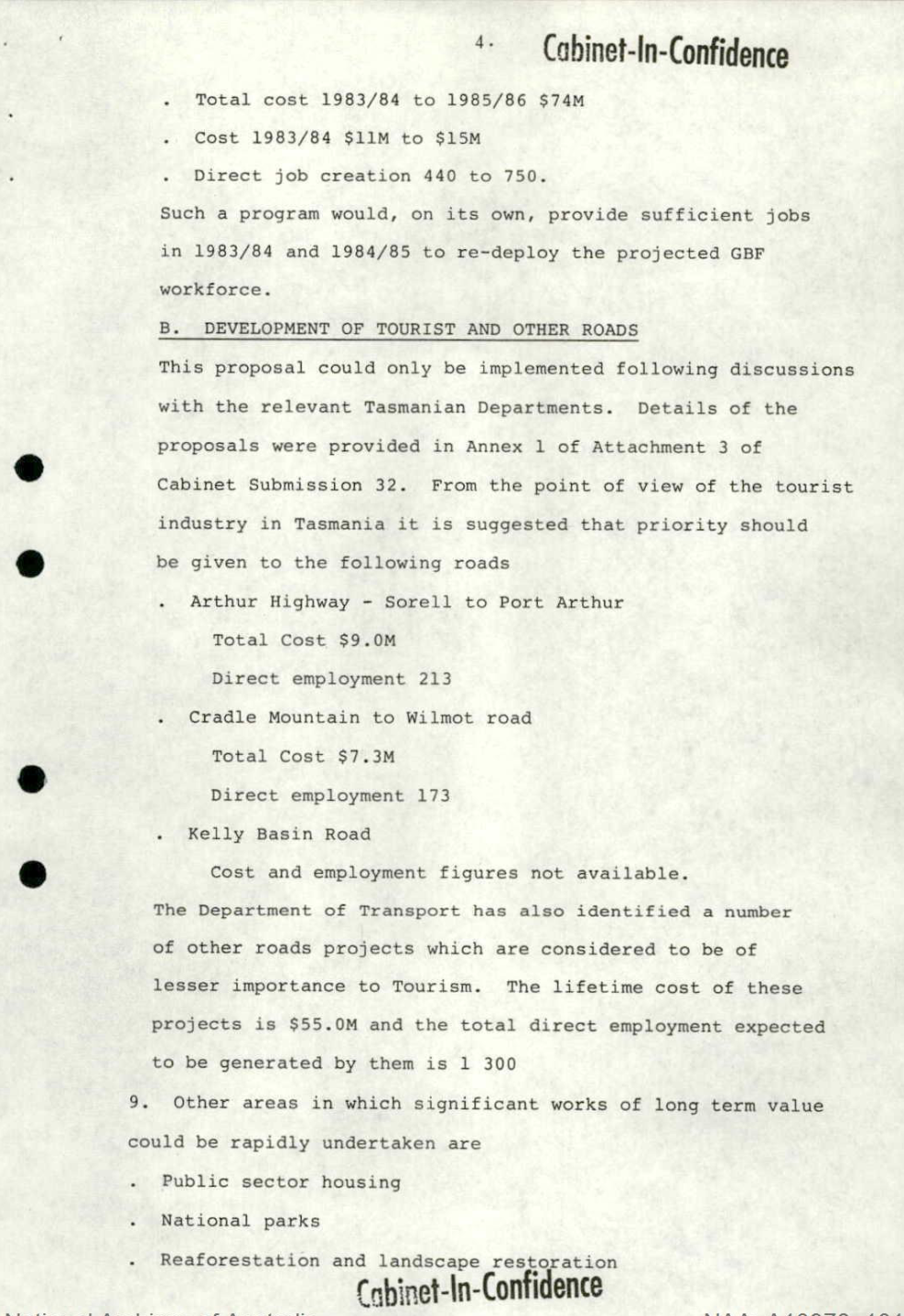
Cabinet minute, Decision 626.



Aboriginal and Torres Strait Islander people should be aware that the National Archives' website and collection contain the names, images and voices of people who have died.
Some records include terms and views that are not appropriate today. They reflect the period in which they were created and are not the views of the National Archives.


Cabinet minute, Decision 626.



[Page 1]
[Header and footer in large red letters:] CONFIDENTIAL
[Header and footer in large black letters:] CABINET-IN-CONFIDENCE
Copy No. 51
[Stamped in black ink:] THIS DOCUMENT IS NOT [underlined] TO BE COPIED
CABINET MINUTE
Canberra, 30 May 1983
Decision No. 626
[Heading:] Memorandum No. 101 and Decision No. 562 (Ad Hoc) – Tasmania : Alternative Employment Proposals for Gordon-Below-Franklin Dam Workforce
The Cabinet:-
(a) noted the Memorandum; and
(b) agreed that, together with other appropriate information, it be used as background for further negotiations with Tasmania; and
(c) noted that the Minister for Science and Technology was developing proposals in relation to high technology industries which might in the longer term be of relevance to the Tasmania employment situation.
(This endorses Decision No. 562 (Ad Hoc) of 24 May 1983)
[Illegible handwritten signature]
Secretary to Cabinet
[Page 2]
[Header] 2.
[Header and footer in bold letters] Cabinet-In-Confidence
TASMANIA – ALTERNATIVE EMPLOYMENT PROPOSALS FOR GORDON-BELOW-FRANKLIN DAM WORKFORCE
1. As a result of the Government’s policy towards the Gordon-below-Franklin (GBF) dam several submissions have already gone before Cabinet outlining alternative employment proposals for workers associated with the current dam project.
2. Since Cabinet last considered this issue further work has been done by Departments to refine and clarify projects which might be included in any indicative offer to Tasmania which focussed on the rapid re-development of GBF workers. Work has also been undertaken to prepare an overview of the resent state of the Tasmanian economy and to consider the future prospects for it. (See attachment 1.)
3. Consideration of a compensatory employment program is being carried out in the context of the HEC’s employment projections for the GBF scheme (attachment 2.) and the employment likely to result after 1985 from the construction of alternative power generation schemes (attachment 3.). First priority being given to projects which are primarily Commonwealth rather than State or Local Government initiatives.
4. The latest estimates of the GBF on site workforce range from 200 to 400. It is calculated that the on site workforce will peak around 770 in 1989-90 and that there will be a further 300 to 400 service/maintenance and clerical staff associated with the project by then. Early estimates indicate that substantial power generation schemes are likely to require, at peak of their construction, a workforce of 400 to 700.
5. Consequently, the objective of any re-deployment program would be the “immediate” creation of around400 jobs increasing to a maximum of 700 by the late 1980s (assuming 400 jobs
[Page 3]
Header] 3.
[Header and footer in bold letters] Cabinet-In-Confidence
created on an alternative power scheme).
6. It has become apparent that the scope for unilateral Commonwealth action, so far as job creation is concerned, is limited. In many areas State approval and or assistance would be required to enable swift implementation. The best prospects for inclusion in any indicative offer to Tasmania relating to the immediate re-deployment of the existing GBF dam workforce are the acceleration of Commonwealth capital works projects, the construction of tourist roads and environmental and forestry projects.
7. As the prime minister has already indicated, any offer made to Tasmania should clearly state that the Commonwealth would wish to consult with the State and possible local Government at the earliest possible stage to consider other proposals.
8. The Department of Resources and Energy believes that the following projects provide the best means available to the Commonwealth to rapidly re-deploy the GBF workforce.
[underlined title] A. ACCELERATION OF AUSTRALIAN GOVERNMENT CAPITAL WORKS
This is the only proposal that could be both funded and implemented by the Commonwealth without the need for prior discussions with Tasmania. Suitable work could include [the following are in dot points]
The Department of Housing and Construction has provided an initial schedule of works which could be included in such a program. Details of this schedule are attached (Attachment 4).
The schedule shows:
[Page 4]
Header] 4.
[Header and footer in bold letters] Cabinet-In-Confidence
[in dot points]
Such a program would, on its own, provide sufficient jobs in 1983/84 and 1985/85 to re-deploy the projected GBF workforce.
[underlined title] B. DEVELOPMENT OF TOURIST AND OTHER ROADS
This proposal could only be implemented following discussions with the relevant Tasmanian Departments. Details of the proposals were provided in Annex 1 of Attachment 3 of Cabinet Submission 32. From the point of view of the tourist industry in Tasmania it is suggested that priority should be given to the following roads
[in dot points]
Total Cost $9.0M
Direct employment 213
Total Cost $7.3M
Direct employment 173
Cost and employment figures no available
The Department of Transport has also identified a number of other roads projects which are considered to be of lesser importance to Tourism. The lifetime cost of these projects in $55.0M and the total direct employment expected to be generated by them is 1 300
9. Other areas in which significant works of long term value could be rapidly undertaken are [in dot points]
Reaforestation[sic] and landscape restoration
This is a record of cabinet minutes from 1983, showing that the Australian Government was aware of the financial and economic impact of preventing the Tasmanian Government from building the controversial Franklin-below-Gordon dam. It also demonstrates a clear approach to addressing the overall unemployment situation in Tasmania.
Before the case was heard by the High Court, the Australian Government committed to provide one month's wages to the workers who were unable to work on the contested site because of the ongoing protest and High Court case. Longer-term solutions were still in development to provide steady jobs in Tasmania, which had the highest unemployment in Australia at the time.
The conservationists and protestors also demonstrated understanding of the issue, often responding to inquiries about the impact on employment by emphasising the potential for tourism to be a stronger industry for Tasmania. The cabinet minutes address this potential for tourism by including upgrades to infrastructure, such as key roads, in their plan for generating jobs. Today, tourism contributes significantly to Tasmania's economy, both in the money that is brought in by visiting tourists and the jobs that are created by the tourism industry.
This cabinet paper also considers the problem of energy in Tasmania, which was another issue created by preventing the construction of the Franklin-below-Gordon dam. With changes to Australian society, including greater use of energy for businesses and in homes, this was projected to be a key area for development in Tasmania.
Due to Tasmania's distribution of natural resources, which include only low amounts of coal and natural gas but many of opportunities for hydroelectricity and wind, they have been well ahead of the rest of Australia in generating clean energy.
Although this was not a topic brought up in favour of the Franklin-below-Gordon dam at the time, the prevention of the project meant that other avenues had to be found to ensure the Hydro-Electric Commission (now called Hydro Tasmania) could continue to meet the needs of the state. They have done so by expanding into wind and solar energy, and by updating and upgrading their hydro-electric facilities.
Do you think that the Cabinet paper offers reasonable employment alternatives to the Franklin-below-Gordon dam?
Are there any other options to decrease unemployment that Cabinet could consider instead?
Learn how to interpret primary sources, use our collection and more.
